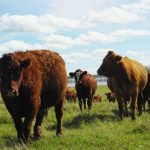CHICAGO, Feb 11 (Reuters) – Demand for bank loans, loan extensions and renewals is surging among U.S. farmers, and farm incomes are forecast to fall for a third year as grain and livestock prices remain stubbornly low, according to a quarterly farm economy report from the Federal Reserve Banks of St. Louis and Kansas City.
But access to such credit tightened in the fourth quarter of 2015, and is expected to continue to be squeezed in the coming year, as the rate of farmers repaying their existing lines of credit slows and the value of their land falls, according to the surveys from the banks, released Thursday morning.
The findings come as the U.S. farm economy continued a downward slide in the fourth quarter of 2015: A strong U.S. dollar, sluggish export demand and a glut of grain have kept bearish clouds over the sector and dragged down wheat prices to nearly six-year lows.
The USDA projected earlier this week that farm net incomes in 2016 would drop to US$54.8 billion, down nearly three percent from a year earlier. These low crop prices also are squeezing cropland values, according to both banks’ surveys.
The Federal Reserve Bank of St. Louis’s region covers part or all of Arkansas, Illinois, Indiana, Kentucky, Mississippi, Missouri and Tennessee. The Federal Reserve Bank of Kansas City’s region includes Colorado, Kansas, Nebraska, Oklahoma, Wyoming, and portions of western Missouri and northern New Mexico.
Cropland values in the St. Louis Fed’s region during the fourth quarter fell by 2.5 percent compared to a year earlier, while ranchland and grazing pastures dropped by 5.3 percent.
Cash rents for quality crop land were down 9.5 percent in the fourth quarter compared with a year earlier, while ranchland or pastureland cash rents increased by 8.6 percent, though bankers expect both to decline in the first quarter of 2016.
In the Kansas City Fed’s region, farmland values also softened. Irrigated farmland values dropped by two percent in the fourth quarter compared to a year earlier, while nonirrigated farmland dropped by four percent, according to the bank’s survey.
Ranchland values also stalled in the fourth quarter, as feeder cattle prices plummeted from the exceptionally high levels earlier in the year, dropping more than 25 percent.
Land prices are expected to continue dropping well into 2016, and liquidity of farm operations remains among bankers’ top concerns, according to the fourth-quarter survey of bankers in the U.S. grain belt.









